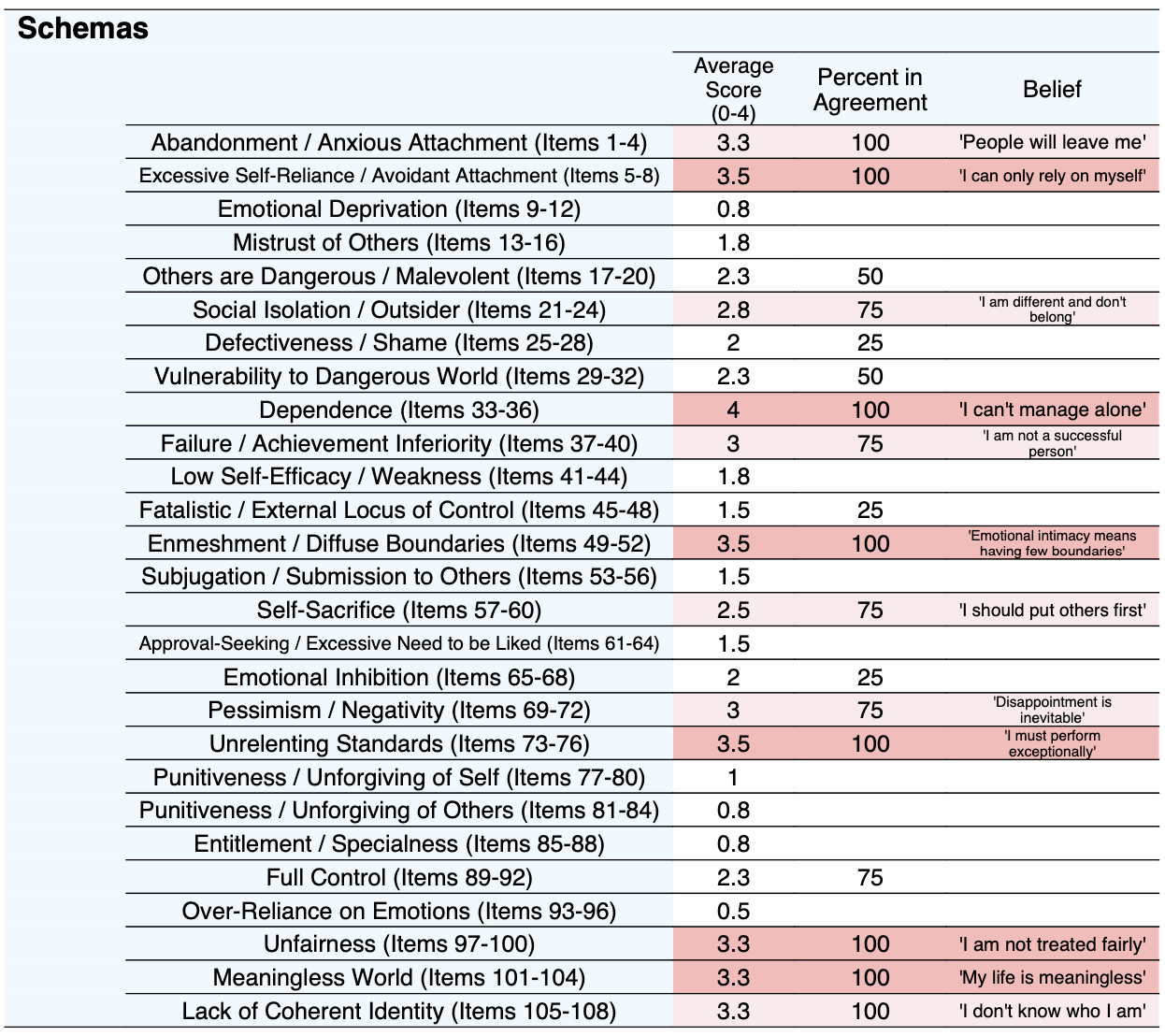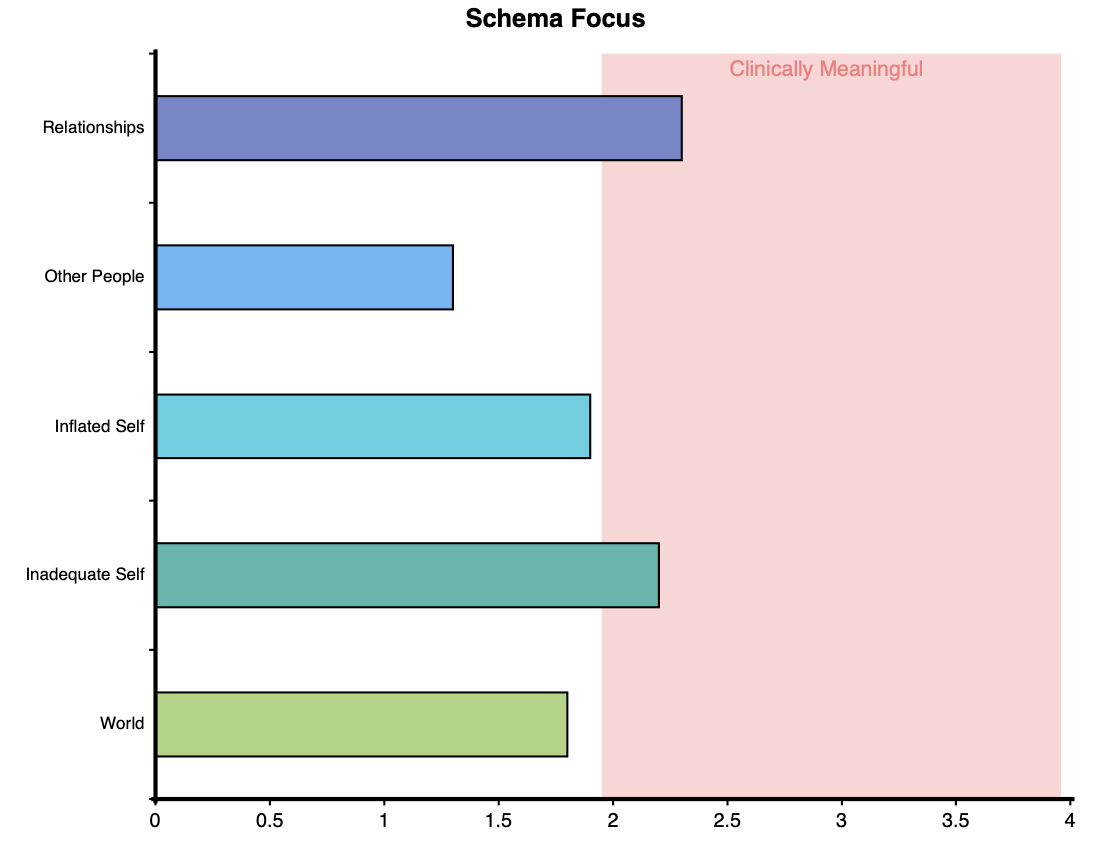The Maladaptive Schema Scale (MSS) is a 108-item tool that assesses maladaptive patterns of thoughts, behaviours and emotions. It measures 27 schemas, integrating traditional early maladaptive schemas described by Jeffery Young and additional schemas based on attachment, trauma and other contemporary research.
The Maladaptive Schema Scale (MSSv1.4) is a 108 item, comprehensive self-report assessment designed to assist mental health professionals in identifying and measuring schemas that are maladaptive and of clinical importance to the development and maintenance of psychopathology. These schemas play a crucial role in people’s understanding of the world, interpretation of experiences, predicting outcomes and informing decisions and emotional responses.
The MSS is designed to assess problematic schemas in clinical populations and inform case conceptualisations for adults experiencing a range of mental health problems, particularly those with complex issues such as personality pathology, interpersonal difficulties, post traumatic stress disorder (PTSD) or a history of abuse. Though the MSS is a transdiagnostic tool, maladaptive schemas have been shown to have important associations with many mental health diagnoses, including PTSD, borderline personality disorder, dissociative disorders, depression and anxiety (Bär et al., 2023).
Developed by the NovoPsych Psychometrics team, the MSS builds on traditional early maladaptive schemas described by Jeffery Young (Young, 1990), and integrates additional schemas based on attachment theory, trauma research and empirical psychometric evidence. The MSS is therefore a more comprehensive schema questionnaire when compared with the Young Schema Questionnaire (YSQ) with 27 schemas yet shorter in length (108 items).
It is also open source, meaning it can be copied and used clinically or in research without explicit permission, overcoming a limiting factor of the YSQ and later derivatives.
The MSS measures 27 maladaptive schemas and groups these schemas into six clusters, representing childhood unmet needs. The empirical basis for core early needs is summarised in Dweck’s unified theory of motivation, personality and development (2017). Based on this and schema therapy theory (Young, 2003), the development of maladaptive schemas occurs due to an interaction between an individual’s temperament and childhood core emotional needs not being met, or another significant disruption in development. Thus, if a respondent has schemas nested within one of the “unmet needs” clusters, it suggests a common etiological basis grounded in early childhood experiences. As schemas pertain not only to the self, the MSS provides additional clinical detail through a second model categorising schemas according to their focus, the World, Inadequate Self, Inflated Self, Other People & Relationships.
In clinical settings, the MSS is used to identify which schemas are contributing to a person’s emotional or interpersonal difficulties. Understanding one’s schemas is instrumental in schema therapy, where the therapeutic focus involves helping clients to:
The MSS measures 27 maladaptive schemas and groups these schemas into six clusters, representing childhood unmet needs.
Safety & Attachment
Autonomy & Competence
Freedom to Express Needs, Opinions & Emotions
Spontaneity & Play
Realistic & Consistent Limits
Coherence & Fairness
Full descriptions of the schemas can be found in the below PDF.
Scores for the 27 subscales are presented as an average score, where the number represents the level of agreement with the schema, as defined by the Likert scale:
Strongly Disagree = 0
Disagree = 1
Neutral = 2
Agree = 3
Strongly Agree = 4
Higher scores are indicative of stronger agreement with maladaptive schemas and are hypothesised to be associated with psychopathology and more dysfunctional relational, emotional or personal functioning.

A schema is considered to be moderate when an average score is 2.5 or more, while the schema is considered to be strong and of clinical significance when higher than the 90th percentile. Scores on the 90th percentile or higher indicate that the respondent scored in the top 10% compared with other patients receiving mental health care. The 90th percentile threshold varies across schemas between an average score of 2.75 (e.g dependence) to 3.5 (e.g. lack of coherent identity). A higher threshold for “strong” indicates that there is a higher prevalence of a “moderate” schema among mental health clients.
A strong schema represents broad agreement with the schemas that are of theoretical importance to schema therapy in addition to a score that deviates from typical patterns of responding.
Maladaptive Schemas with Strong Agreement / Percentage in Agreement
Scores are also presented as the percentage of responses where the client “Agreed” or “Strongly Agreed” with the items in the subscale, producing a “Percent in Agreement” metric.

Childhood Unmet Needs Schema Clusters

In addition, scores are presented for each of the six early childhood needs. High scores on a need cluster strongly suggest that the cause of the schema is rooted in early childhood experiences. Scores of 2 or above are considered clinically meaningful and are suggestive of a childhood need that was chronically disrupted.
Safety & Attachment
Autonomy & Competence
Freedom to Express Needs, Opinions & Emotions
Spontaneity & Play
Realistic & Consistent Limits
Coherence & Fairness

Schema Focus Categories
Schemas are also categorised into five focal points. These categories help clinicians discern the focus of schemas and identify patterns of internalising and externalising.
World
Inadequate Self
Inflated Self
Other People
Relationships

 The Maladaptive Schema Scale was developed in 2024, and involved an extensive literature search to identify schemas, core beliefs or world views that are associated with psychopathology. Existing schema constructs were identified and the importance of those schemas in psychotherapy practice were ranked by three experienced psychologists. Research using natural language processing techniques and artificial intelligence were used to systematically identify similar constructs (Mussel, 2023).
The Maladaptive Schema Scale was developed in 2024, and involved an extensive literature search to identify schemas, core beliefs or world views that are associated with psychopathology. Existing schema constructs were identified and the importance of those schemas in psychotherapy practice were ranked by three experienced psychologists. Research using natural language processing techniques and artificial intelligence were used to systematically identify similar constructs (Mussel, 2023).
In order to identify existing measures of maladaptive schemas, literature on the theoretical underpinnings of schema therapy were reviewed, and newly identified constructs such as unfairness, lack of coherent identify, and lack of meaningful world (Arntz et al., 2021) were included in the shortlist of schemas.
Thirty existing psychometric instruments were reviewed, with the following scales being among those to be of key importance to MSS scale development: Young Schema Questionnaire (Young, 1990), Word Assumption Scale (Janoff-Bulman, 1989), Attachment Style Questionnaire – Short Form (Chui & Leung, 2016), and General Self-Efficacy Scale (Schwarzer & Jerusalem, 1995). The MSS represents a synthesis and enhancement of the concepts found in these scales, schemas identified by Mussel (2023), Arntz et al. (2021) and Dweck’s (2017) unified theory of personality and development. A shortlist of 38 schemas were further condensed into the 27 by NovoPsych Psychometrics team using clinical experience and empirical evidence.
These iterative improvements have led to the current version (v1.4), the result of rigorous psychometric evaluation from a Modern Test Theory approach (Rasch Analysis) to ensure its reliability and validity as a comprehensive tool for assessing maladaptive schemas.
The primary validation study for v1.4 (n=192) was carried out by the NovoPsych Psychometrics team, taking 138 items from the v1.2 and reducing them to 125 for v1.3, and then to 108 in v1.4 on the basis of conceptual meaning guided by Rasch indices such as model and item fit statistics, item difficulty and residual correlations.
Findings of the MSSv1.4 validation found, for all 27 schemas, a non-significant X² chi-square indicating global model fit, no concerning residual correlations, and strict unidimensionality assessed via Smith’s test, in addition to measurement invariance by gender. Appropriate between-schema correlation patterns were observed. For example, Defectiveness was positively correlated to schemas such as Failure and Lack of Coherent Identity. Lack of Coherent Identity was also associated with greater variance in responding. For more details on the psychometric properties of the MSSv1.4, see the MSSv1.4 Manual.
Buchanan, B., Bartholomew, E., Smyth, C., & Hegarty, D. (2024). A comprehensive questionnaire for schemas related to psychopathology: The Maladaptive Schema Scale – Version 1.4 (MSSv1.4). https://doi.org/10.17605/OSF.IO/C3UPR
Arntz, A., Rijkeboer, M., Chan, E., Fassbinder, E., Karaosmanoglu, A., Lee, C. W., & Panzeri, M. (2021). Towards a reformulated theory underlying schema therapy: Position paper of an international workgroup. Cognitive Therapy and Research, 1-14.
Bär, A., Bär, H. E., Rijkeboer, M. M., & Lobbestael, J. (2023). Early Maladaptive Schemas and Schema Modes in clinical disorders: A systematic review. Psychology and Psychotherapy, 96(3), 716-747. https://doi.org/10.1111/papt.12465
Chui, W.-Y., & Leung, M.-T. (2016). Adult attachment internal working model of self and other in Chinese culture: Measured by the Attachment Style Questionnaire—Short Form (ASQ-SF) by confirmatory factor analysis (CFA) and item response theory (IRT). Personality and Individual Differences, 96, 55-64. https://doi.org/10.1016/j.paid.2016.02.068
Dweck, C. S. (2017). From needs to goals and representations: Foundations for a unified theory of motivation, personality and development. Psychological Review, 124, 689-719. https://doi.org/10.1037/rev0000082
Janoff‐Bulman, R. (1989). Assumptive worlds and the stress of traumatic events: Applications of the schema construct. Social Cognition, 7, 113-136. https://doi.org/10.1521/soco.1989.7.2.113
Mussel, P. (2023, May 15). Core beliefs about the self: A structural model based on a systematic review and natural language processing. https://doi.org/10.31234/osf.io/ky4vu
Schwarzer, R., & Jerusalem, M. (1995). Generalized Self-Efficacy scale. In J. Weinman, S. Wright, & M. Johnston (Eds.), Measures in health psychology: A user’s portfolio. Causal and control beliefs (pp. 35-37). NFER-Nelson.
Young, J. E. (Ed.). (1990). Cognitive therapy for personality disorders: A schema–focused approach. Professional Resource Press.
Young, J. E., Klosko, J. S., & Weishaar, M. E. (2003). Schema therapy: A practitioner’s guide. Guilford Press.
Young, J.E. (2014). List of Early Maladaptive Schemas (2nd ed.). Retrieved from https://www.schematherapy.org/inventories-as-ebooks
NovoPsych’s mission is to help mental health services use psychometric science to improve client outcomes.
© 2023 Copyright – NovoPsych – All rights reserved